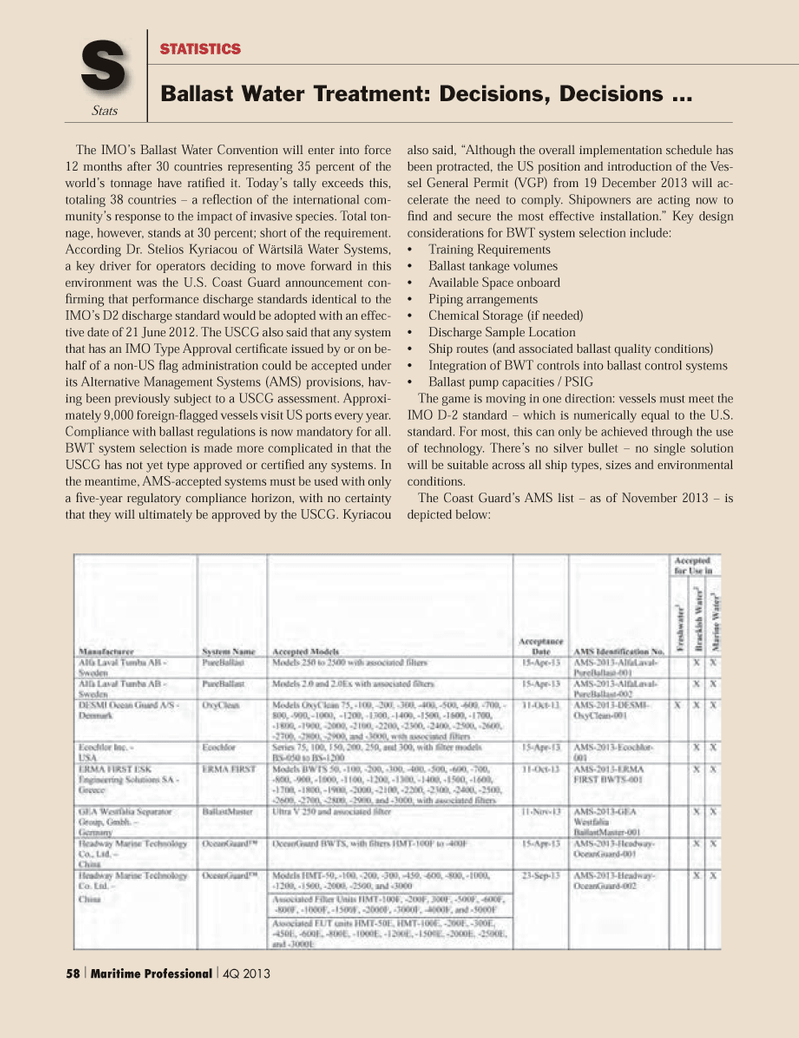
Page 58: of Maritime Logistics Professional Magazine (Q4 2013)
Shipbuilding, Repair
Read this page in Pdf, Flash or Html5 edition of Q4 2013 Maritime Logistics Professional Magazine
StatsSTATISTICS Ballast Water Treatment: Decisions, Decisions ? SThe IMO?s Ballast Water Convention will enter into force 12 months after 30 countries representing 35 percent of the world?s tonnage have rati ed it. Today?s tally exceeds this, totaling 38 countries ? a re ection of the international com- munity?s response to the impact of invasive species. Total ton- nage, however, stands at 30 percent; short of the requirement. According Dr. Stelios Kyriacou of Wä rtsilä Water Systems, a key driver for operators deciding to move forward in this environment was the U.S. Coast Guard announcement con- rming that performance discharge standards identical to the IMO?s D2 discharge standard would be adopted with an effec- tive date of 21 June 2012. The USCG also said that any system that has an IMO Type Approval certi cate issued by or on be- half of a non-US ag administration could be accepted under its Alternative Management Systems (AMS) provisions, hav- ing been previously subject to a USCG assessment. Approxi- mately 9,000 foreign- agged vessels visit US ports every year. Compliance with ballast regulations is now mandatory for all. BWT system selection is made more complicated in that the USCG has not yet type approved or certi ed any systems. In the meantime, AMS-accepted systems must be used with only a ve-year regulatory compliance horizon, with no certainty that they will ultimately be approved by the USCG. Kyriacou also said, ?Although the overall implementation schedule has been protracted, the US position and introduction of the Ves- sel General Permit (VGP) from 19 December 2013 will ac- celerate the need to comply. Shipowners are acting now to nd and secure the most effective installation.? Key design considerations for BWT system selection include: Training Requirements Ballast tankage volumes Available Space onboard Piping arrangements Chemical Storage (if needed) Discharge Sample Location Ship routes (and associated ballast quality conditions) Integration of BWT controls into ballast control systems Ballast pump capacities / PSIG The game is moving in one direction: vessels must meet the IMO D-2 standard ? which is numerically equal to the U.S. standard. For most, this can only be achieved through the use of technology. There?s no silver bullet ? no single solution will be suitable across all ship types, sizes and environmental conditions. The Coast Guard?s AMS list ? as of November 2013 ? is depicted below: 58 | Maritime Professional | 4Q 2013MP #4 50-63.indd 58MP #4 50-63.indd 5812/11/2013 2:07:58 PM12/11/2013 2:07:58 PM

 57
57

 59
59
